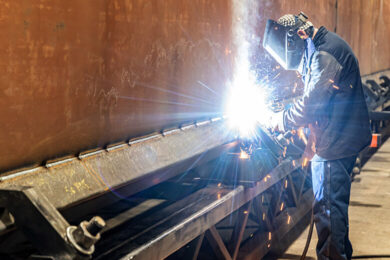Your top three positioners questions answered in a three-minute read
 As experts in positioners, we hear from manufacturers in industries far and wide. While their large-scale assembly and fabrication needs vary, one thing is consistent: they’re looking for better, faster and safer processes.
As experts in positioners, we hear from manufacturers in industries far and wide. While their large-scale assembly and fabrication needs vary, one thing is consistent: they’re looking for better, faster and safer processes.
That’s where best-in-class positioners come in – helping deliver higher efficiency, improved productivity and reduction in safety issues.
If you’re thinking about how to improve your process, but just haven’t found time to learn more about positioners, we’re making it easy. Check out this three-minute read answering the most commonly asked questions about the power of positioners.
How do positioners work?
Think of it like a giant chicken rotisserie.
Positioners can be categorized as single-column or headstock/tailstock. They are designed to lift, tilt, and rotate any weldment or fixture, so that it can be accessed and handled safely and quickly. The result is a streamlined assembly process that improves employee well-being and comfort – and offers up to a 40+% increase in productivity.
The positioner’s headstocks and tailstocks control elevation and are synchronized to stay level. Most parts are held in the fixtures as close as possible to the center of gravity. The positioner can lift a part to provide clearance for rotation, rotate the part and then lower it back down to give the welder access to the work area. All of this can be done in minutes with only one person.
What does a positioner have to do with quality welds?
Quality and ergonomics go hand in hand. Positioners improve weld quality because they position the joint in the same place at a comfortable reach with good visibility. This facilitates consistent, repeatable procedures. The end result is better welds.
Workers can effortlessly flip, hold and rotate the product they’re working on with the push of a button. No more constant ladder climbing or kneeling uncomfortably. Instead, workers can focus on the overall quality of their product.
Welding OEMs advise that a joint in the 1F or 2F position allows for better penetration and improved deposition rate. A 1F position is a fillet weld that holds the joint at 45 degrees and allows for the best deposition rate. It is the easiest joint to weld. A 2F position is a flat fillet weld at 90 degrees. Orienting the part in either of these positions will result in better welds. Also, with the part in a better position, it is much easier for a welder to make sure that welds aren’t missed.
Why is a positioner going to increase speed, or throughput?
Fabricators that install positioners usually see the benefits quickly. Production starts to increase, and welders realize that they can do more while being safer and less fatigued.
Positioners maximize arc time. When welders have to stand around waiting for cranes or while rigging a fixture to move or reposition a large part, labor hours are wasted. Using a positioner allows the operator to safely speed up the handling portion of rotating a part and orient that part for the best weld access. This saves labor hours and increases the welder’s arc time.
A welder can also be more efficient with a part in the correct orientation. With the weldment positioned properly, a welder can avoid having to weld overhead, vertically, under or in other awkward positions that hinder productivity. Positioners that allow the welder to access parts in a better and more comfortable position empower him or her to deposit more material at a quicker rate.
These improvements are important because they help experienced welders work more efficiently. They also help newer, less experienced welders learn their jobs more quickly and easily. By combining improved value-added work with reduced nonproductive, indirect labor, manufacturers can meet their needs to produce more with their existing workforce.
Ready to see how a positioner can make your process more productive?
We’d love to talk. Give our team a call at (309) 787-6200 or fill out our form.

